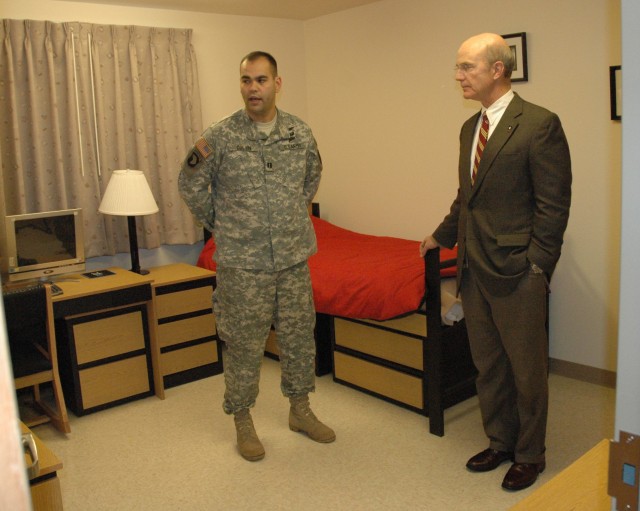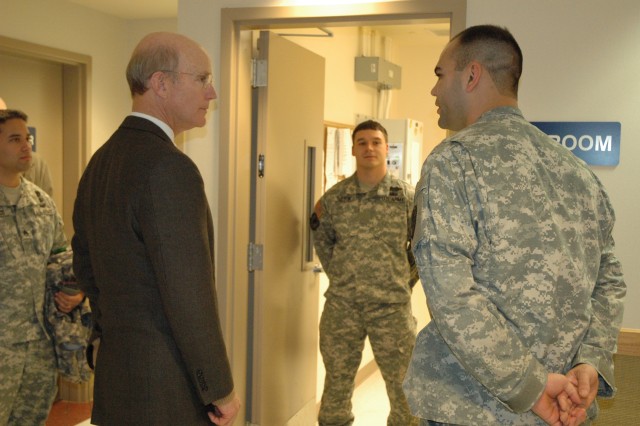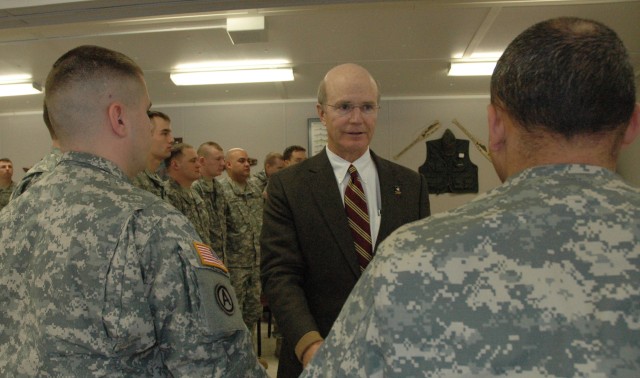FORT RICHARDSON, Alaska (Army News Service, Nov. 21, 2008) -- Secretary of the Army Pete Geren visited Fort Richardson to talk with wounded warriors as part of his trip to the Pacific during Warrior Care Month.
Aca,!A"There are parts in the Army that have carried a heavier load in the Global War on Terrorism,Aca,!A? Geren said to a room full of reporters and warriors in transition. Aca,!A"Our Soldiers and families have carried the biggest load.Aca,!A?
Geren said he felt it was important to check on the Soldiers and their families assigned to the Fort Richardson Warrior Transition Unit.
Aca,!A"The Warrior Transition Unit is a relatively new approach of taking care of our outpatients,Aca,!A? Geren said. Aca,!A"Our warriors in the WTU are the best students of the process.Aca,!A?
He said the best people to talk to about how the medical care system has changed are the wounded warriors.
Aca,!A"Anytime I can get advice from them, I take it,Aca,!A? he said.
Thirty-two WTUs officially stood up in January 2008 across the Army, Geren said. Of that number, Alaska has one each at Fort Richardson and Fort Wainwright.
According to Geren, WTUs were created because the staff at Walter Reed Army Medical Center in Washington, D.C., had not been able to keep up with the outpatient cases the Army had since the start of Operations Iraqi and Enduring Freedom.
Aca,!A"Our WTUs have been operational for (about) a year now,Aca,!A? Geren said. Aca,!A"ItAca,!a,,cs a brand new initiative, and itAca,!a,,cs taken us a while to get it right.Aca,!A?
WTUs have made a big difference in the care of the Soldiers, Geren said.
Aca,!A"We have been continuously fine-tuning it, so anytime an organization as big as the Army tries to do something new, we have to learn as we go,Aca,!A? Geren said. Aca,!A"ThatAca,!a,,cs why we have meetings with Soldiers like this.Aca,!A?
According to Army officials, WTUs provide high-quality living conditions, prevent unnecessary procedural delays and establish conditions that facilitate physical and mental healing. WTUs were also created to assist wounded warriors with a smooth conversion to civilian life if they choose to separate from or are medically boarded out of the Army.
The WTU staff works hand-in-hand with the Soldier Family Assistance Center to figure out a plan for each Soldier who walks through the WTU doors.
Aca,!A"Today, IAca,!a,,cve met with several wounded warriors here, and I have talked with them to make sure we are doing a good job taking care of them,Aca,!A? Geren said. Aca,!A"IAca,!a,,cve heard today they are really pleased with their care here.
Aca,!A"All the issues they raised today had nothing to do with the care they have received at the WTU; the concerns (IAca,!a,,cve heard) have got to do with Aca,!Eoebig ArmyAca,!a,,c and not the WTU,Aca,!A? Geren continued.
Geren said Fort Richardson wounded warriors expressed aggravations and frustration with paperwork and other administrative issues handled at the Department of the Army level.
Aca,!A"The feedback has been good, and every place I go, I get good ideas and suggestions on how to make it better,Aca,!A? he said.
GerenAca,!a,,cs discussion turned from wounded warriors to the part Alaska troops are expected to play in future operations.
According to Geren, Alaska, in particular, will continue to play an important part of the future of the Army, and will continue to grow considerably.
The Army announced Sept. 12 its decision to add 1,775 troops at Fort Richardson and 425 more at Fort Wainwright.
Aca,!A"Two billion dollars worth of construction is also on the books for Alaska,Aca,!A? Geren said.
New barracks, training areas and housing are among the projects scheduled to be completed during the next several years.
He said the Alaska military population is going to grow to around 30,000 people. That number takes into consideration the families who will accompany Soldiers to their assignment to Alaska.
Geren said the infrastructure to take care of those Soldiers and their families is guaranteed to be in place.
The growth in Alaska is expected to be finished by 2020, he said.
Aca,!A"Alaska will remain a major deployment platform for the Global War on Terror,Aca,!A? Geren said.
(Sharon McBride serves with Fort Richardson PAO.)








Social Sharing